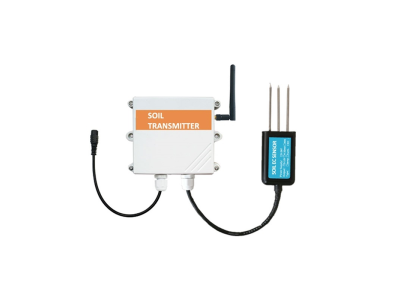Agriculture is the backbone of our society, providing us with the food and resources we need to thrive. However, traditional farming practices often lack precision and efficiency, leading to resource wastage, environmental degradation, and reduced yields. In recent years, the emergence of soil sensor technology has revolutionized farming practices by enabling farmers to gain real-time insights into soil conditions. This article explores the growing trend of using soil sensors in agriculture and the transformative impact they have on farm productivity.

Understanding Soil Sensor Technology:
Soil sensor technology involves the use of advanced sensors that are deployed in the ground to monitor various soil parameters. These sensors can measure factors such as soil moisture, temperature, nutrient levels, pH, and salinity. By collecting and analyzing this data, farmers can make informed decisions about irrigation, fertilization, and other farming practices. Soil sensor technology provides valuable insights into soil conditions that were previously inaccessible, allowing farmers to optimize their agricultural practices and enhance farm productivity.
Soil Moisture Sensors:
One of the key applications of soil sensors is measuring soil moisture levels. Soil moisture sensors are typically installed at different depths in the soil profile, allowing farmers to monitor moisture content at various stages. This information helps farmers determine the optimal time for irrigation, preventing overwatering or water stress. By maintaining soil moisture at the ideal levels, plants can efficiently absorb nutrients, reduce water waste, and enhance overall crop health. Soil moisture sensors are especially beneficial in regions with limited water resources, as they enable farmers to use water more efficiently.
Nutrient Sensors:
Proper nutrient management is crucial for healthy plant growth and high-quality yields. Soil sensors equipped with nutrient probes allow farmers to measure essential elements like nitrogen, phosphorus, and potassium concentrations in the soil. This data enables farmers to adjust fertilizer applications precisely, avoiding excessive or insufficient nutrient supply. By optimizing nutrient levels, farmers can minimize environmental pollution, reduce production costs, and optimize crop nutrition. Nutrient sensors also help farmers identify nutrient deficiencies or imbalances in the soil, allowing for targeted corrective measures.
Temperature and pH Sensors:
Soil temperature and pH are important factors that influence plant growth and nutrient availability. Soil sensors equipped with temperature and pH probes provide real-time data on these parameters. This information allows farmers to make informed decisions regarding planting schedules, crop selection, and soil amendments. By ensuring the optimal temperature and pH range, farmers can create favorable conditions for root development, microbial activity, and nutrient uptake, ultimately leading to improved crop productivity. Temperature and pH sensors are particularly useful in regions with extreme climates or soils with specific pH requirements.
Environmental Monitoring:
Soil sensors not only provide insights into soil conditions but also contribute to overall environmental monitoring on farms. For example, soil sensors can detect salinity levels, which is crucial in regions where excessive salt content can negatively affect plant growth. By monitoring salinity levels, farmers can implement appropriate soil management practices to mitigate salinity issues. Soil sensors can also help monitor soil erosion, allowing farmers to take preventive measures to protect their soil and maintain its fertility. Furthermore, by integrating soil sensor data with weather data, farmers can develop climate-smart farming strategies that adapt to changing environmental conditions.
Precision Agriculture and Data Analytics:
The integration of soil sensor technology with data analytics and precision agriculture techniques enhances its effectiveness. The sheer volume of data generated by soil sensors necessitates advanced data analytics techniques for effective interpretation and decision-making. Farmers can integrate soil sensor data with satellite imagery, weather data, and historical records to gain comprehensive insights into their fields. Data analytics platforms and decision support systems equipped with machine learning algorithms can analyze this data and provide actionable recommendations for optimizing crop management. These systems can suggest precise irrigation schedules, fertilizer applications, and pest management strategies, leading to increased productivity and reduced environmental impact.
Benefits of Soil Sensor Technology:
The use of soil sensors in agriculture offers numerous benefits. Firstly, soil sensors provide farmers with real-time and continuous monitoring of soil conditions, allowing them to detect changes promptly and take immediate action to prevent crop stress or yield losses. Secondly, soil sensors enable farmers to make data-driven decisions and optimize resource allocation. By tailoring farming practices based on the specific needs of each crop and field, farmers can maximize yields, reduce costs, and minimize resource wastage. Additionally, soil sensor technology promotes sustainable farming practices by minimizing water usage, fertilizer runoff, and environmental pollution.
Future Directions:
While soil sensor technology has already made significant strides, there are still exciting developments on the horizon. The future of soil sensor technology lies in the development of wireless and autonomous sensor networks. Wireless sensor networks eliminate the need for physical wiring, making sensor installation and maintenance more convenient and cost-effective. Autonomous sensor networks leverage artificial intelligence and machine learning algorithms to automate data collection, analysis, and decision-making processes. These advancements will further enhance the accessibility, accuracy, and usability of soil sensor technology, making it more widely adopted among farmers of all scales.
Conclusion:
Soil sensor technology is transforming agriculture by providing farmers with real-time insights into soil conditions and enabling precise decision-making. By utilizing soil moisture sensors, nutrient probes, temperature and pH sensors, farmers can optimize irrigation, fertilization, and other farming practices to maximize crop productivity while minimizing resource waste. The integration of soil sensor technology with data analytics and precision agriculture techniques further enhances its effectiveness. As soil sensor technology continues to evolve, it holds the potential to revolutionize agriculture, making it more sustainable, efficient, and productive, thereby ensuring food security for future generations.






